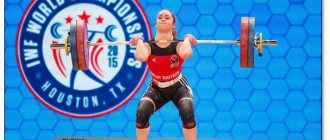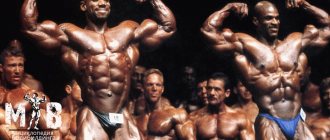Work, perseverance, willpower, endurance - a person who decides to take up a sport like weightlifting cannot do without this. Training in this sport is a whole system that must be followed if you want to achieve a truly impressive result. This topic is very interesting. It contains a lot of details, details and specific nuances. It’s impossible to tell about everything, but the most important things are worth noting.
Start date
Weightlifting training for beginners, of course, is radically different from the programs used by experienced professionals. But they were just getting started. There has been a lot of controversy about what the sequence of the methodological path should be. So far, no scientific research has been carried out on the issue, the results of which gave a substantiated answer to this question.
Classic exercises must be done in three groups: a jerk with two hands, lifting the barbell to the chest and pushing up from it. When mastering them, you need to remember the characteristics of the sport. The goal of weightlifting is to lift maximum weights. Therefore, the technique of competitive exercises must be studied in combination with a load (apparatus).
If a person does not comply with these fundamental requirements, then there will be consequences. In essence, he will master an erroneous, amateurish technique. If there is no significant additional weight, then the load during acceleration/braking of the bar will not reach the required value.
Already at this stage, a comprehensive approach can be seen, which requires the athlete to perform a number of additional exercises aimed at muscle development. For their successful growth, by the way, you need to follow proper nutrition, which implies a high protein content.
Training planning for a beginner weightlifter.
Beginning weightlifters should only use a) snatch, b) push exercises, c) squats and d) bench presses in their training. The ratio and balance of exercises in a monthly training both in the preparatory and competitive stages is approximately: a) snatches - 20%, b) barbell cleans - 13, c) barbell cleans - 12, d) squats with a barbell shoulders and chest - 30, e) other barbell squats - 18% and f) bench press - 7% of the total volume.
It is important to understand that planning a training session for a beginner weightlifter is carried out under the strict guidance of a coach and the strict supervision of the doctor supervising you. "Do no harm!" - this is the very first commandment in “iron sports”.
Classes of the 1st training cycle look something like this.
September
1-2 lessons. Half-squat chest raise 55 X ХЗХ 1 ; 65X3X5. Push push, without squatting 55X Uz*X 1; 65X UzX5. Squats with a barbell on the shoulders—50X5X1; 60X4X5. Squats with a barbell on the chest using the “scissors” method - 40X5X3.
3-4th lessons. Half squat snatch – 50 X 3 X 1; 60X3X5. Push push, without squatting - 55хУзХ XI; 65Х*/зХЗ. Squats with a barbell with arms straight at the top using the “spread” method – 40X4X4. Chest push - 40X3X4. Squats with a barbell on the shoulders - 55Х6Х 1; 65X6X5.
5-6th lessons. Half-squat snatch —50ХЗХ X 1; 60X3X5.
Snatch - 40X4X4. Half squat clean + chest push – 55X 2; 65 X UZH 4. Squats with a barbell on the shoulders - 65X6X4. Wide grip bench press - 60 X 5 X 3.
Front squats using the scissors method - 40X4X4.
7-8th lessons. Half squat clean - 65 X 4 X 4. Snatch - 55 X 3 X 2; 60 X 3 X 5. Squats with a barbell on the shoulders - 70X5X6. Chest push - 40X3X3. Squats with a barbell with arms straight at the top using the “spread” method – 40X4X4.
9-10th lessons. Snatch with a half-squat - 65X4X X 5. Clean-up with a half-squat variation "spread" ("scissors") - 55X ZX 1; 65X3X3. Half-squat clean + clean and jerk - 70X / 3X 3. Squats with a barbell on the shoulders - 70 X 5X 4. Close grip bench press - 65X5X5. Squats with a barbell - a projectile on the chest using the scissors method - 50 X 5X 3.
11-12th lessons. Snatch - 55 X 2X 1; 60X3X1; 65X4X5. Squats with a barbell with arms straightened at the top using the “spread” method - 50 X 5 X 4. Push (from racks) - 60X2X1; 70X2X4. Squats with a barbell on the front - 50Х7Х 1; 60X6X4.
The final part of each lesson includes exercises with a metal stick, simulating the snatch and jerk technique. If a beginner cannot perform a snatch or clean with the “spread” option, he is taught a “scissors” lift. Subsequently (after 0.5-1 year), if the athlete is able to lift the barbell using the “straddle” method, he will be transferred to this method.
The distribution of the September load (1150 lifts) by week will be as follows: 1st week - 262 lifts, 2nd - 324, 3rd - 288, 4th - 276 lifts.
October
In the first week you need to repeat lessons 7, 8, 9, in the second - 10, 11, 12 (these will be lessons 13-18). From the third week you can start a new cycle.
19-20th lessons. Half-squat snatch - 60X ZX XI; 65X3X5. Squats with a barbell on the front using the 1st scissor method - 60X6X 4. Clean and jerk - 60X X 3; 70X1 X /zHZ. Squats with a barbell on the shoulders - 70X1 X6X6. Wide grip bench press – 65X 6X 4.
Lessons 21-22. Half squat clean - 1 65X5X4.
Dash —50ХЗХ 1; 60X3X1; 65X3X6. Squats with a barbell with arms straight at the top in the “spread” variation - 50X6X3. Shvung push (from racks) - 1 60X5X4. Front squats - 60X1 X6X5.
23-24th lessons. Half-squat snatch - 60 X 4 XI XI; 70X4X4. Clean with a squat option: “spread” (“scissors”) - 60 X 4 X 4. Squats with a barbell with arms straightened at the top using the “spread” method - 50X6X3. Chest push (from racks)—55X3X1; 65X3X3. Squats with a barbell on the shoulders - 60Х4Х 1; 70X5X7.
Load distribution in October: 1st week - 288, 1 2nd - 276, 3rd - 364, 4th - 322 lifts.
November
It is necessary to repeat the October training cycle, reducing the load by 25 lifts in the 1st and 3rd weeks. Then the distribution of the monthly load (1200 lifts) will be: 1st week - 263 lifts, 2nd - 276, 3rd - 339, 4th - 322 lifts.
December
At the end of the month, the weightlifter must compete, and for this it is necessary to know his readiness. In the snatch and clean and jerk, lifts of heavy weights are additionally (in a small amount) included. Here's what a sample weekly training cycle plan looks like:
- Monday. Dash - 60X ZX 1; 70X3X2; 80X X2X2; 85X1X2. Squats with a barbell with arms straight at the top using the “spread” method - 50X5X4. Half squat clean 60 X 3 X 1; 70 X ХЗХ 1; 80X3X1. Squats with a barbell on the shoulders - 60X6X1; 75X5X5 (total for training - 75 lifts).
- Wednesday. Snatch with half squat - 55X 4X 1; 65Х4Х XI; 75X4X1- Push -55X2/gX1; 65X2/gX1; 75Х Х2/gХ 1; 85Х2/гХЗ. Squats with a barbell on the shoulders - 65X4X1; 75X4X4. Close grip bench press -70X X5X4. Front squats using the “scissors” method – 60 X 6X 3 (in total for the workout – 94 lifts).
- Friday. Half-squat clean - 60 X X4X1; 75X4X3. Squats with a barbell with arms straight at the top in the “spread” variation - 50X4X4. Push shwung (from racks) - 65 X 4X 1; 75X3X3. Front squats - 60X 6X 1; 70Х6Х Х5 (total for training - 81 lifts).
This weekly training cycle can be used for a month, only slightly modifying the exercises and varying the volume of the load. The volume of monthly load can be distributed by week as follows: 1st week - 250 lifts, 2nd - 300, 3rd - 250, 4th - 200 lifts. Let’s not forget about quality rest and good nutrition. Be sure to supplement your diet with vitamins, minerals, and, of course, protein shakes and sports nutrition. Buying high-quality protein, creatine or gainer is not a problem these days - numerous Ru-Net online stores can help you. And in every small town there is a specialized store for bodybuilders, lifters and weightlifters.
In the future (in the 2nd and 3rd training cycles), the volume of load in the preparatory and competitive months can be distributed over weekly cycles approximately as follows.
Preparatory month (1100 lifts), 1st week - 275, 2nd - 310, 3rd - 250, 4th - 265 lifts; competition month (900 lifts) - 240, 300, 210 and 150 lifts, respectively.
Weekly training planning for a beginner weightlifter during this period is not difficult. The volume of the load is distributed so that in the first workout (which usually begins after a two-day rest) there is a maximum number of lifts, and in the second, after a heavy load, there is a minimum. For example, in the first week of the preparatory month, the load (275 lifts) can be distributed as follows: Monday - 110, Wednesday - 75 and Friday - 90. In the second week (310 lifts) - 120, 90 and 100, respectively.
For a beginner, it is very important to choose the optimal weight of the barbell in training. However, his maximum results in various exercises are unknown, because the athlete does not yet master the technical techniques. You can determine the weight of the barbell that a beginning weightlifter should train with in the first 3-4 months using the calculation tables that every trainer has.
In this table, the results are given on the basis that the strength capabilities of beginners at 16 years old are approximately within 70% and at 17 years old - within 75% of the results of the III sports category. And since in the first months the athlete does not lift heavy weights and trains with minimal, small and medium weights, the weights will always be within his strength. After the first competitions have been held and the maximum possible results in the snatch and clean and jerk have been identified, calculations are made based on the achievements shown. In other exercises, the same initial data are taken for calculations.
Now you know how to plan a training session for a beginner athlete, and you can adopt a ready-made scheme, slightly adapting it for yourself. It has already been noted that the main task of beginners is to study the technique and improve it, so the training plans proposed above can be used by beginning weightlifters of almost any level of fitness.
- < Back
- Forward >
Mastering the Snatch
This is where weightlifting begins. Training aimed at familiarizing the athlete with the technique takes place with a barbell pole without weights. It all starts with pulling exercises and the starting stance. That is, a person lifts the barbell to the chest, while straightening the body and legs. Exercises are performed not only from the floor, but also from a certain height (the pole is taken from a box, stand, etc.).
You cannot do without these exercises, since only with their help a beginner can learn to straighten the body correctly. Only after mastering this technique can you begin lunge jerks. In no case with a squat! To get to this point, you must first master the basics and gain experience.
When learning to snatch, novice athletes perform general movement exercises without a apparatus. After that, they learn to clean the barbell. First without lunging. You can get to it only through mastering the squat. It is important to remember that traction plays an important role here, so you should not neglect performing exercises from different positions. By the way, the chest push is also performed without lunges at first.
To connect it with the push, you need to place the barbell on the racks, aligning them at chest level. This is the starting position. From there the athlete performs a push and a lunge. Once these movements are mastered at a decent level, you can combine them.
Weightlifting workouts for beginners
What a novice athlete needs to know:
- First, determine the goal of your training; the intensity and type of training depends on the desired result. Maybe you want to get into the world of big-time sports or you would just like to strengthen your own body, in each of these cases the activities and intensity will be different;
- Next, prepare a place for training, or sign up for a gym;
- find a smart coach;
- Do not spare money on purchasing special equipment.
Before you buy a subscription, you should keep in mind that a regular gym will not suit you, since you need a specially equipped sports ground. Weightlifting training will bring maximum benefit and help you achieve the desired result.
Weightlifting workouts for beginners
Remember that today it is not necessary to hire a personal teacher or trainer, because you can easily find relevant materials in text and video format on the Internet. Just pay attention to the professionalism of the presenter; do not mindlessly repeat the technique of performing the exercises after the trainer.
Working on biceps
Weightlifting cannot do without it. Workouts, as beginners believe, should include bending (exercises with dumbbells, for example) to make the arms larger. But in fact this statement is somewhat erroneous. It is necessary to do the notorious exercises, as well as everything that can help with them: deadlifts and overhead presses, squats on the front and back, pushes. The bottom line is that this is what affects the size of your arms. Power snatches, pull-ups with a snatch and push grip, squat cleans - this can significantly strengthen your arms. To be more precise, the brachialis and brachioradialis muscles.
Many trainers do not recommend doing bending at all, because they waste energy, and it can be spent on more useful exercises that contribute to the development of larger muscle groups that affect the efficiency of lifting weights. Moreover, the vast majority of flexions have a negative impact on arm flexibility. And it is necessary to lift the barbell.
Professional athletes, when describing weightlifting training for beginners, place special emphasis on the fact that large arms, which beginners often chase after, often lead to problems with holding the barbell in the front position. And no matter how much strength an athlete has, it will be difficult to lift and push due to the lack of flexibility. Therefore, if you want not only to be a weightlifter, but also to have huge arms, you need to forget about bending and pay more attention to deadlifts.
A complete list of basic exercises with detailed descriptions
| ! | Remember! There should be no distortions during movements. They should be performed smoothly, without beating |
Bench press. This is the main exercise that helps develop the upper body. There are a lot of options for implementation. Here you can remember both the bench press with a narrow grip and with a wide one; bench press with a pause and so on. In bodybuilding, the bench press is practiced without a bridge. After fixing the bar at the top, you need to smoothly lower the bar until it touches your chest. After this we carry out the reverse movement.
Target muscles: pectorals. Additionally, the shoulders and triceps are worked.
Squats. Squats are the main exercise for developing strength and gaining mass. No highly effective training program is complete without squats. There are many variations of squats: front squats, wide-legged squats, narrow-legged squats, pause squats. Squats work the leg muscles, back muscles and upper body. After the athlete has moved away from the racks with the barbell, it is necessary to firmly secure the back and shoulder girdle, moving the shoulders back. Only after this should you smoothly lower yourself into a sitting position. The depth of the squat is adjusted individually.
Target muscles: quadriceps. Additionally, the following are worked: calves, thighs, buttocks, lower back.
| ! | Remember! In deadlifting, you should not suddenly throw the barbell after lifting. This has a negative effect on the lower back |
Deadlift. This is the second most important exercise after the squat. There are 3 types of deadlifts: classic deadlifts, sumo deadlifts and intermediate deadlifts. First of all, it is necessary to firmly secure the lower back, creating a slight deflection in it at the start. It is also necessary to move your shoulders back. All this will help keep your back tight. After this you can start climbing. In deadlifting, you should not suddenly throw the barbell after lifting. This has a negative impact on the lower back.
Target muscles: lower back. Additionally, the following are worked: quadriceps, calves, thighs, buttocks, mid-back, forearms, trapezius, latissimus dorsi.
Push-ups on parallel bars. The main load falls primarily on the triceps.
Target muscles: triceps. Additional muscles: chest, shoulders.
Military press or standing press. There are various options for performing the standing press. Many of them are related in one way or another to changes in grip size. They do it with both a barbell and dumbbells. Perform either standing or sitting. Don't forget about the head press. In some ways, the shvung can be considered a type of military press.
Target muscles: shoulders. Additional muscles: triceps, mid back.
Pull-ups. Pull-ups should always be present in a bodybuilder's arsenal, as they help increase muscle mass in the back. They are very effective. Especially wide grip pull-ups. Only a few will be able to do a large number of repetitions.
Target muscles: latissimus dorsi. Additional muscles: biceps, forearm, middle back.
Tractions. Rows are perhaps the basis for the upper back. They are performed with both a barbell and dumbbells. One of the most effective options: bent-over T-bar row. Despite the fact that exercises on machines are not so effective, pulling a block to the stomach wonderfully loads the back muscles.
Triceps
But there is no way to do weightlifting without working out this part of the arms. Training must include exercises for their development. Large triceps are not only a hindrance - they will help when lifting the barbell.
To develop them you need to do bench presses. These exercises develop both the shoulders and arms, and the back and legs. In other words, they help improve the supporting force needed to secure the barbell overhead and then hold it. It is the active execution of bench presses with the maximum possible weight that contributes to the appearance of the huge horseshoe-shaped triceps observed in the best athletes.
These exercises must be approached responsibly. All the weight must be squeezed out, and this is not as easy as it may seem. And when it starts to work out really well, you need to add another 10 kilograms. And then another 10. And so systematically. It’s difficult, but just look at the results of professionals who, using a similar technique, have learned to squeeze a weight that is one and a half times their own! And this is not the limit. Russ Knipp, for example, bench pressed twice his own weight.
Weighted push-ups also influence the development of triceps (as well as the back, arms and legs, respectively). It is worth combining them with a bench press, since such push-ups work the triceps differently. We must remember that this muscle is much more complex than the biceps, so it is worth performing different exercises to engage all its parts and achieve the best result.
Techniques for performing exercises in weightlifting
The combined event program for the Olympic Games includes two exercises. But to complete a weightlifting exercise program, you need to remember all three simple elements:
- Snatch – lifting the barbell above your head in one movement, with your arms straight, at the same time you need to perform a Popov’s step or a low sit. Next, you need to fully straighten your legs while holding the barbell above your head.
- The next exercise, the push, consists of two parts. First, you need to take the barbell to your chest, lifting it off the platform, while simultaneously entering a low squat or Popov’s cross-leg, and rise up. Then do a half squat and with a sharp movement lift the barbell up with straight arms. The legs are in a shwung position (legs slightly to the side) or “scissors” (legs forward and back). Next, you need to fix the barbell above your head and straighten your legs. The feet should be parallel, the barbell above the head.
- The third exercise, the bench press, is now excluded from the Olympic program due to the risk of injury and difficulty in judging. Now it is used in training athletes. The essence of the exercise is to lift the barbell from the platform to the chest, and then press it overhead using only the arm muscles. It is this moment that is difficult for judges to control, since some dishonest athletes helped themselves in lifting with their whole body.
Assistive technology
Since it is highly recommended to include weighted push-ups in your weightlifting training plan, it is necessary to talk about how to do them.
First you need preparation. A beginner needs to learn how to do three sets of twenty full push-ups. When successful, you can add weight. Some weightlifters use a belt specially designed for this purpose. Others hold dumbbells between their legs. Still others place a barbell “pancake” on their back. All options are good, but if a person intends to engage in this sport professionally, then he will need a belt in any case.
So what is the purpose of push-ups? 50 kilograms + athlete weight. Having achieved this goal, you will need to increase it. Add weight little by little. It is recommended to do push-ups every week and change the number of approaches and repetitions each time. Four by eight, five by three, two by five, three by three. And once a month - a record push-up. But all approaches should always be completed by performing the exercise with a reduced weight. Minus 25 kilograms - and as many times as possible.
Another exercise that should be included in your weightlifting training plan is the straight arm pullover. Why is it needed? Because this exercise works the long part of the triceps to the maximum. It is done either with dumbbells or with a barbell. To perform a pullover, you need to lie on a bench (your head should hang over the edge) and accept the barbell from someone who will help. Having determined the amplitude that is convenient for you, you need to extend your arms to the starting position. Then do a pullover (one set - 20 repetitions) and rest. We must remember - your arms should be as straight as possible. Bending is allowed at the moment when the dumbbell/barbell falls below the head. In preparation for the second approach, it is worth taking more weight. Many beginners are surprised to note that the next 20 repetitions with heavier dumbbells are easier than the first.
Weightlifting Equipment - Body Development and Training Plan
Drawing up a program yourself is, of course, commendable, but it’s still better to get basic knowledge from a real professional, and only then rely on your own knowledge and experience. A highly qualified specialist will quickly and efficiently teach you basic skills, develop a training program and the right diet.
Weightlifting Equipment - Body Development and Training Plan
Equipment is an important part of training for a beginning athlete, various elements of which will help you avoid injuries and increase the effectiveness of your activities. Now all that remains is to make your weightlifting training plans and reap the fruits of your labor. Do not forget also that at first you should pay attention to the complex work of the muscles of the whole body, avoiding isolated exercises if possible.
- If you have good physical fitness, then you can go straight to intense exercise. In any case, it is better to consult an experienced trainer. In addition, you should undergo an examination at the hospital or make an appointment with your doctor to be sure of your readiness for training.
Methodology A.S. Medvedev
I would like to pay special attention to the long-term training system in weightlifting developed by Alexei Sidorovich Medvedev, a Soviet weightlifter, champion and record holder of the USSR, Europe and the world. This man published more than 400 works (17 of which abroad), which he devoted to the development of this sport in the country and in the world, as well as to the organization and planning of the educational and training process.
His weightlifting training system is recommended for every person who wants to train professionally. The best publication is considered to be the work published in Moscow in 1971, known as “Multi-year training planning.”
Medvedev emphasized that weightlifting is a speed-strength discipline in which two facets of activity are inextricably linked. Practicing this sport involves improving both physical qualities (including special ones) and technical skills. Every athlete must understand that weightlifting is impossible without creating the best biomechanical conditions for action that can realize his potential.
Alexey Lovchev updated two world records this night and became the strongest man on the planet
"I did it! Friends, thank you to everyone who believed and supported me! Russia is the greatest power, and we are proof of this!” - Alexey Lovchev wrote on his page a few hours after he became the world champion and updated two legendary world records.
World records in the heavyweight category for men are so rare that the last time it happened was in the last century (2000 is the last century, right?). Then the colorful Iranian (who isn’t colorful in this weight class?) Hossein Rezazadeh lifted 472 kg (the result for weightlifters is the sum of two attempts - in the snatch and clean and jerk) and won the Sydney Olympics.
Yesterday in Houston, America, that seemingly eternal record was broken by a simple Russian guy from Karabanovo, a town at the junction of the Moscow and Vladimir regions. So simple that when asked about his main post-sports dream, he always answered - to open a car service center in his city and work on cars.
“I've never lifted this much weight before - I'm stunned. This proves that Russia is the strongest nation. I couldn't have done this without the support of my parents. My father is a coach, it was he who introduced me to weightlifting. My mother died in 2012, and I dedicate this victory and these records to her,” Lovchev began weightlifting from the age of nine, and lifted his first weights in the gym that his father built.
Lovchev's record attempt at 264 kg is an excellent motivational video for those who are used to giving up when things get tough.
Most likely, you haven’t watched this - it’s not customary for us to spend the second hour of Saturday night on weightlifting. That’s why you won’t see how, after a successful approach to 248 kg (the second attempt, which actually secured gold for Lovchev), the coaches told Lovchev leaving the platform - let’s go for 64? He didn’t even answer, just nodded his chin. What questions do you have, of course we’ll go...
My friends and I are celebrating the victory of our team!
“When I was little, I often watched Rezazadeh lifting huge weights on TV. He was an example for me, I could never imagine that one day I would surpass his record,” - that night, 26-year-old Lovchev did something he couldn’t believe - he became the strongest man on the planet.
With the Minister of Sports Vitaly Mutko and my friend Alexander Ivanov
One caveat is worth making here.
Officially, Lovchev now has two world records - the most important one in the combined event and a separate one in the clean and jerk (it also used to belong to Rezazade, but stood a little less - since the 2004 Olympics in Athens). The record in the snatch still remains with another Iranian, Behdad Salimi - Lovchev was three kilograms short of the 214 kg he took four years ago.
But in reality, Lovchev has so far only repeated the best sum in the history of weightlifting, and in the clean and jerk his result is only the third. Why is that?
The thing is that world records in weightlifting were reset three times - in 1993 and 1998, the International Federation redrew the weight categories, and the countdown of new achievements began from the beginning.
Therefore, all the results that weightlifters suffered before 1998 are probably undeservedly forgotten. Let’s just remember - in 1988, when the super heavyweight category began not with 105 kg, as now, but with 110 kg (is there a fundamental difference in the lower limit of absolute weight?), Leonid Taranenko pushed the barbell at 266 kg (four years earlier 265 kg pushed by Anatoly Pisarenko) and gained a total of 475 kg.
Not a bad benchmark for Lovchev, who in two years after his international debut (bronze at the 2013 World Championships - the first big start in Alexey’s career) added 11 kg in the snatch and 34 kg in the clean and jerk. Then another Russian, Ruslan Albegov, won, just like a year ago in Alma-Ata, where Lovchev “rammed” the jerk, leaving him with no result at all.
“Ruslan and I have a good relationship. There is no tension, let alone hostility, we communicate regularly in the hall,” we will save the confrontation between Lovchev and Albegov for the next Olympic year.
“The decision not to take Albegov to Houston is strategic. He and Lovchev were ready to work according to world records and did not want to exhaust them with this confrontation,” the head coach of the national team, Alexander Venkov, explained the sudden exclusion of Albegov from the team’s application.
As for Alexey, he could have set a world record in the snatch, but we made a general decision to simply ensure an advantage over his competitors before the clean and jerk. And only when, after two attempts in the clean and jerk, it became clear that Alexey had won gold, he, in agreement with personal trainers and the national team’s coaching staff, went for a world record. And he returned the highest world achievement in the super heavyweight category to Russia - after two decades of leadership of Iranian weightlifters.
All world record holders in the heavyweight category in history (the most recent records set are indicated):
Hristo Plachkov (Bulgaria) - 442.5 kg; Vasily Alekseev (USSR) - 445 kg; Anatoly Pisarenko (USSR) - 457.5 kg; Alexander Gunyashev (USSR) - 465 kg; Antonio Krastev (Bulgaria) - 467.5 kg; Alexander Kurlovich (USSR/Belarus) - 472.5 kg; Leonid Taranenko (USSR) - 475 kg; Andrey Chemerkin (Russia) - 462.5 kg (after the results were reset in 1993); Ronnie Weller (Germany) - 465 kg; Hossein Rezazadeh (Iran) - 472.5 kg; Alexey Lovchev (Russia) - 475 kg.
With my coach Sergei Ivanov and two-time Olympic champion, four-time world champion Alexander Kurlovich
World Championship
Houston, USA
Men
Over 105 kg
1. Alexey Lovchev (Russia) - 475 kg (211 kg + 264 kg) - world record
2. Lasha Talakhadze (Georgia) - 454 (207 + 247)
3. March Seim (Estonia) - 438 (190 + 248)
Quotes: Inside The Games, WodLoft, All Sports
Photo: instagram.com/lovchev_aleksey
Material provided by Sports.ru
Training philosophy
The Soviet approach had a special vision for weightlifting. Physical activity was perceived as a stimulus to which the body reacts by changing its functions. That is, as a result of training, there is an intensification of metabolism, improved blood circulation and energy exchange, active breathing and much more. Yes, upon completion, the athlete’s condition will stabilize. But the effects of the workout, like the increased metabolism, continue.
Awareness of this physiological feature was the basis of the Soviet approach. Training is not just physical activity and a way to fill muscles with micro-tears. This is what affects the restructuring of the body and affects the biological system as a whole. Seeing the load from this perspective gives a holistic view of the impact of the stressor (training) and helps to maximize the potential of a weightlifter when creating an individual program for him.
Training program
Week 1
Select the weight of the barbell based on your training. It shouldn't be too hard for you, but it shouldn't be easy, choose the average values.
- Monday
- Jerk – 5 x 2+1
- Push Pull – 3 x 3
- Back Squats – 3 x 5
- Wednesday
- Dash – 5 x 2
- Snatch Row – 3 x 3
- Front Squats – 3 x 3
- Thursday
- Rack Snatch – 5 x 2
- Power clean + clean and jerk – 5 x 2(1+1)
- Overhead Squats – 3 x 3
- Saturday
- Snatch - maximum power
- Jerk – maximum power
- Front Squats - Maximum Strength
Week 2
In the second week, the same weight is used as in the first week, only with an increased volume of load. If it's too easy for you, you can increase the weight, but don't increase it by much.
- Monday
- Jerk – 5 x 3+1
- Push Pull – 4 x 3
- Back Squats – 5 x 5
- Wednesday
- Dash – 5 x 3
- Snatch Row – 4 x 3
- Front Squats – 5 x 3
- Thursday
- Standing Snatch – 5 x 3
- Power clean + clean and jerk – 5 x 3(1+1)
- Overhead Squats – 5 x 3
- Saturday
- Dash – 6 x 1
- Jerk – 6 x 1
- Front Squats – 3 x 1
Week 3
Increase your weight compared to last week
- Monday
- Jerk – 5 x 1
- Push Pull – 3 x 3
- Back Squats – 5 x 3
- Tuesday
- Power Snatch – 5 x 3
- Hanging Chest Raise – 5 x 2
- Wednesday
- Dash – 5 x 1
- Snatch row - 3 x 3
- Front Squats – 5 x 2
- Thursday
- Hanging Snatch – 5 x 3
- Power clean + clean and jerk – 5 x 1+1
- Overhead Squats – 5 x 1
- Saturday
- Snatch - maximum strength
- Jerk – maximum power
- Front squats - maximum strength
Week 4
Increase your weight compared to last week so that you reach your maximums by Saturday.
- Monday
- Jerk – 5x1
- Push row – 3x2
- Back squats – 5x2
- Tuesday
- Power snatch – 5x2
- Power clean - 5x2
- Wednesday
- Dash – 5x1
- Snatch lift – 3x2
- Front squats – 3x2
- Thursday
- Hanging snatch – 5x2
- Power clean + clean and jerk 4x1+1
- Overhead squats – 3x1
- Saturday
- Snatch – one rep max
- Jerk – one rep max
- Front Squats - 1 rep max
Bulgarian training system
In weightlifting, the name of such a coach as Ivan Abadzhiev is widely known. He trained the champions of Qatar and Turkey, so many are guided by his programs.
The good thing about the Bulgarian method is that there is no danger of overtraining. The principle is this: by moving consistently and gradually, you manage to adapt your body to stress, which is initially physical activity for it. Ideally, you should spend half of your active day training and not take days off. That's what weightlifting is. Training once a week is not a way to achieve visible results in this sport.
In addition, the likelihood of injury and chronic fatigue is much less if you do not take days off, since adrenaline constantly circulates through the body, promoting protein synthesis. Also, professional athletes who train using this method adapt to the most impressive weights in advance, while their opponents try them only directly in competitions.
However, the essence of the methodology can be described by Abadzhiev’s main motto, which all his students learn. And it goes like this: “Never try to do less than the maximum.”
Weightlifting belt
The weightlifting belt is a very controversial piece of equipment in this sport, which has many opponents and supporters. Professional athletes say that getting used to the belt leads to gradual degradation of the abdominal muscles; as a result, the athlete will not be able to lift even minimal weight without the device.
Weightlifting belt
However, for beginner athletes it is still recommended to use a belt; an inexpensive synthetic product is perfect for such purposes. Gradually you need to accustom yourself to doing exercises without a belt. Also, beginners should remember that they need to develop the natural protection of the lower back and spine - the muscles of the abdominal and pelvic region. The belt should be made of natural material, such as leather.
Useful tips
Weightlifting training involves performing a variety of exercises, many of which seem simple, but are actually very specific and complex. Therefore, it is important to take recommendations into account during the process.
A weightlifting training program includes exercises that begin with hanging barbells. To get them, you need to fix it in its original position for three to four seconds.
It is recommended to do exercises to develop the abdominal muscles and back muscles before each workout. Both with and without weights. The norm is 4 sets of 8 repetitions, then you can increase it if desired. Then you need to perform a series of jumps.
When performing the same type of exercises, there is no need to do intermediate approaches. It is also recommended to try different weights before starting. And, by the way, adjust the load according to how you feel.
When doing snatch deadlifts, you need to take 3-4 seconds to stop, fixing the barbell. The exercise is performed confidently, but without fuss. The barbell lowers calmly.
Also, universal weightlifting training programs include bending over with weights. You need to choose a weight that can realistically be lifted 8 times in 4 approaches.
Designations
5x3 means 5 sets of 3 reps
5x2+1 means 5 sets of 2 repetitions of the first movement and 1 repetition of the second movement. For example, a 5x2+1 clean and jerk means 5 sets of 2 reps of cleans followed by one 1 overhead clean.
A strength max means that on that day you work one rep at a time until you reach your maximum for the exercise. Typically, three unsuccessful attempts to complete an exercise is considered to be the maximum for the day.











